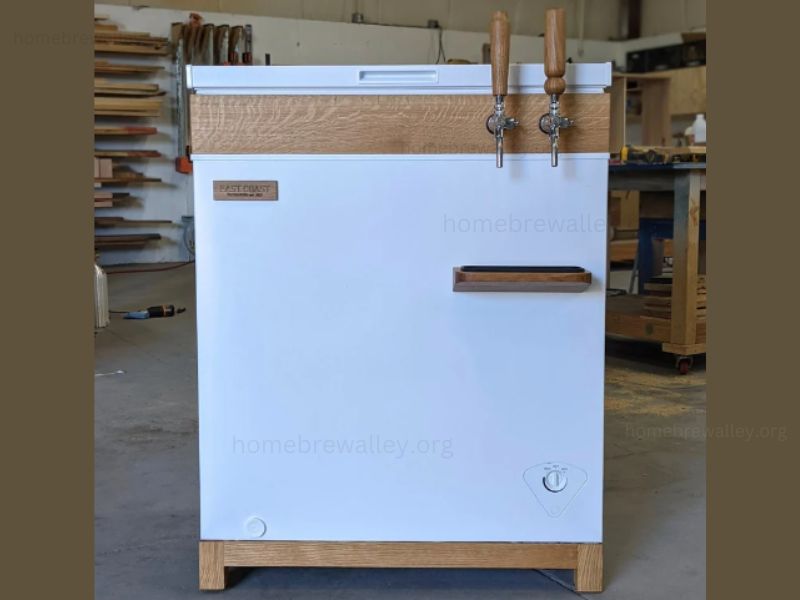Alright, let’s talk about turning your grandma’s fridge into a beer dispenser. Yes, you heard that right. This marvelous invention, aptly named the DIY Kegerator, allows you to transform that old fridge sitting in your grandma’s basement into the ultimate beer-serving machine. No longer will you have to fumble with cans or deal with warm beer, because this bad boy will turn your favorite brew into a perfectly chilled and perfectly poured masterpiece. So grab your toolbox, put on your DIY cap, and get ready to impress your friends with your newfound keg-tapping skills. Cheers!
Choosing the Right Fridge
Size and Capacity
When it comes to choosing the right fridge for your DIY kegerator project, size does matter. You’ll need to consider how many kegs you want to dispense at once and how much space you have available. Remember, you’ll need to make room not only for the kegs but also for the CO2 tank, tubing, and any additional accessories you may want to add. So, before you rush out to buy the biggest fridge you can find, make sure you measure your space and plan accordingly.
Temperature Control
Beer tastes best when it’s served at the right temperature, so you’ll want a fridge that allows you to control the temperature. Look for a fridge with a digital thermostat that allows you to set and maintain the desired temperature. This way, you can always keep your beer at the perfect serving temperature, whether you prefer a crisp lager or a rich stout.
Door Configuration
Believe it or not, the door configuration of your fridge can make a difference when it comes to kegerator conversion. Ideally, you’ll want a fridge with a top-mounted freezer or no freezer at all. The reason? Well, the top-mounted freezer allows for more usable space inside the fridge, making it easier to fit your kegs and other kegerator components. Plus, without a freezer, you won’t have to worry about defrosting or dealing with icy beer lines. So, when you’re scouting for the perfect fridge, keep an eye out for the right door configuration.
Preparing the Fridge for Conversion
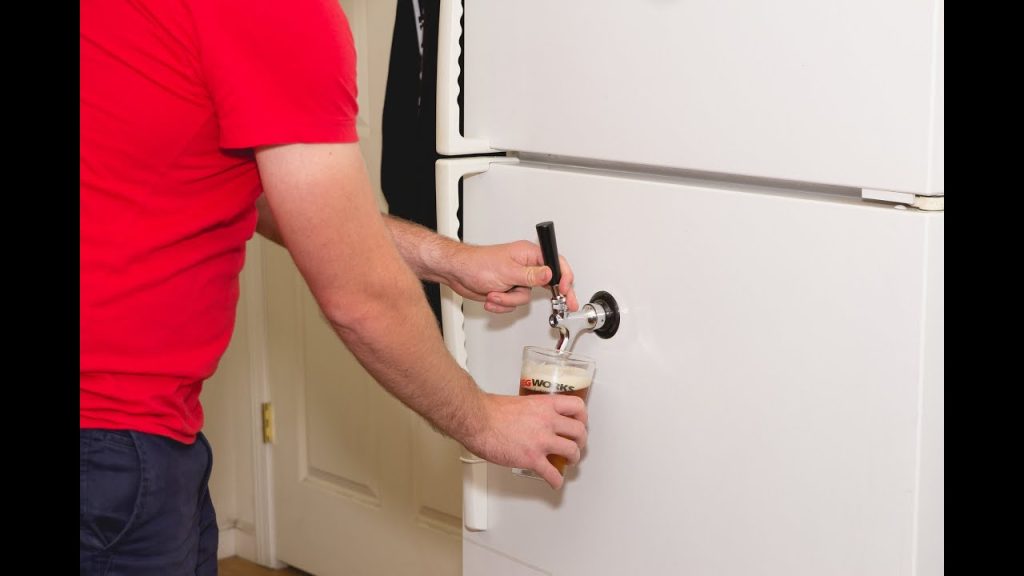
Cleaning and Sanitizing
Before you start turning your grandma’s old fridge into a beer dispenser, it’s crucial to clean and sanitize it. You don’t want any remnants of last Thanksgiving’s turkey ruining the taste of your perfectly crafted homebrew. Start by emptying the fridge and removing any shelves or drawers. Give them a good scrub with warm, soapy water, and don’t forget to sanitize them using a food-safe sanitizer. As for the interior of the fridge, wipe it down with a mixture of water and vinegar to eliminate any lingering odors and bacteria.
Removing Shelves and Drawers
To make room for your kegs, you’ll need to remove any unnecessary shelves and drawers from the fridge. Remember, you want to maximize the interior space to accommodate the height of your kegs and the draft system components. So grab your toolbox and unscrew those shelves and drawers, but keep them safely stored away in case you ever decide to convert your kegerator back into a regular fridge.
Sealing and Insulating
Now that your fridge is spick and span, it’s time to seal and insulate it. This step is essential to maintain the temperature inside the kegerator and prevent any unwanted air leaks. You can use weatherstripping or silicone caulk to seal any gaps or openings in the fridge. Pay special attention to the door seal, as a tight seal is crucial for temperature control. To insulate the walls of the fridge, you can use foam board insulation or even old beer koozies. Get creative and make sure your kegerator is as airtight as possible.
Installing the Draft System
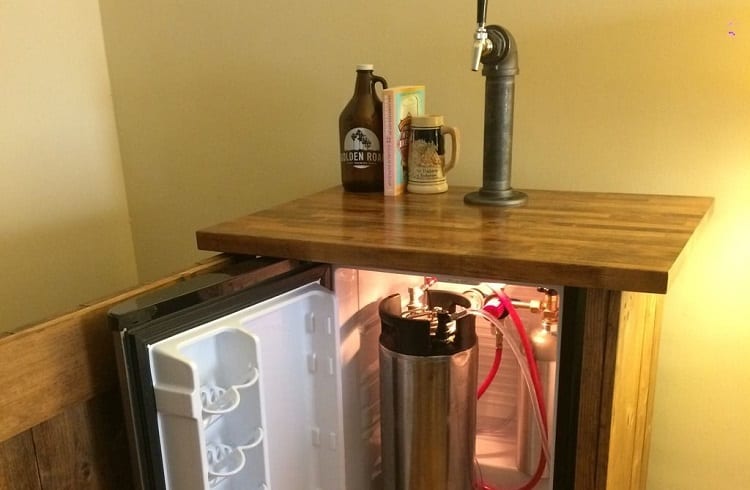
Tap Tower Installation
The tap tower will be the showstopper of your kegerator, so you want to make sure it’s installed properly. Start by measuring and marking the location where you want the tap tower to go. Use a hole saw or a jigsaw to create a hole in the top of the fridge. Gently feed the beer line and CO2 tubing through the hole, making sure they are long enough to connect to the kegs. Finally, secure the tap tower in place using the included mounting hardware, and you’ll be one step closer to pouring your own pints of golden goodness.
Faucet and Shank Assembly
Now that you have your tap tower installed, it’s time to assemble the faucet and shank. Start by attaching the faucet to the shank using the appropriate hardware. Then, carefully insert the shank through the pre-drilled hole in the fridge door or wall, making sure the faucet is facing outward. On the inside of the fridge, attach a beer nut and a tailpiece to the shank, securing them tightly. This will ensure a proper seal and prevent any leaks when you start dispensing that liquid gold.
Beer Line and CO2 Tubing
With the tap tower and faucet assembly in place, it’s time to connect the beer line and CO2 tubing. Start by cutting the beer line to the desired length, keeping in mind the distance between the kegs and the tap tower. Attach one end of the beer line to the tailpiece on the shank, using a hose clamp to secure it tightly. On the other end of the beer line, attach a quick-disconnect fitting, which will connect to the coupler on the keg. Repeat this process for each beer line you’re using. As for the CO2 tubing, connect it from the CO2 tank to the regulator, and then from the regulator to the quick-disconnect fitting on the keg coupler. Make sure all the connections are secure and leak-free, and you’ll be ready to start pouring your favorite brews.
CO2 Setup and Regulation
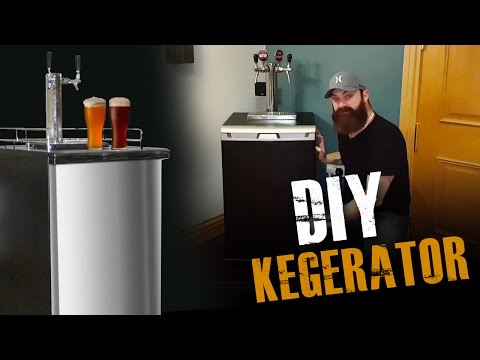
CO2 Tank Selection
When it comes to selecting the right CO2 tank for your kegerator, you have a few options. The most common sizes are 5-pound and 10-pound tanks, but you can also find smaller or larger ones depending on your needs. Consider the size of your kegerator and how often you plan on using it when choosing the tank size. Remember, a larger tank will require less frequent refills, but it will also take up more space in your fridge. Don’t forget also to check the hydrostatic test date on the tank to ensure it’s safe and up to date.
Regulator Installation
To control the flow and pressure of CO2 into your kegs, you’ll need a gas regulator. Start by attaching the regulator to the CO2 tank, making sure it’s tightly secured. Then, connect one end of the CO2 tubing to the output port on the regulator, and the other end to the quick-disconnect fitting on the keg coupler. The regulator should have a pressure adjustment knob that allows you to fine-tune the pressure according to the type of beer you’re dispensing. Experiment with different pressures until you find the sweet spot that gives you the perfect pour.
Pressure Adjustment
Finding the right pressure for your beer is crucial to achieving the perfect pour. Different beer styles require different pressures, so it’s important to do a bit of research and experimentation. Generally, a pressure of around 10-12 psi is a good starting point for most beers. However, if you’re pouring a beer with higher carbonation, like a wheat beer, you may need to increase the pressure. On the other hand, if you’re pouring a beer with lower carbonation, like a stout, you may need to decrease the pressure. Keep tweaking the pressure until you achieve that ideal head of foam that makes your taste buds dance with joy.
Kegging and Connecting the Beer
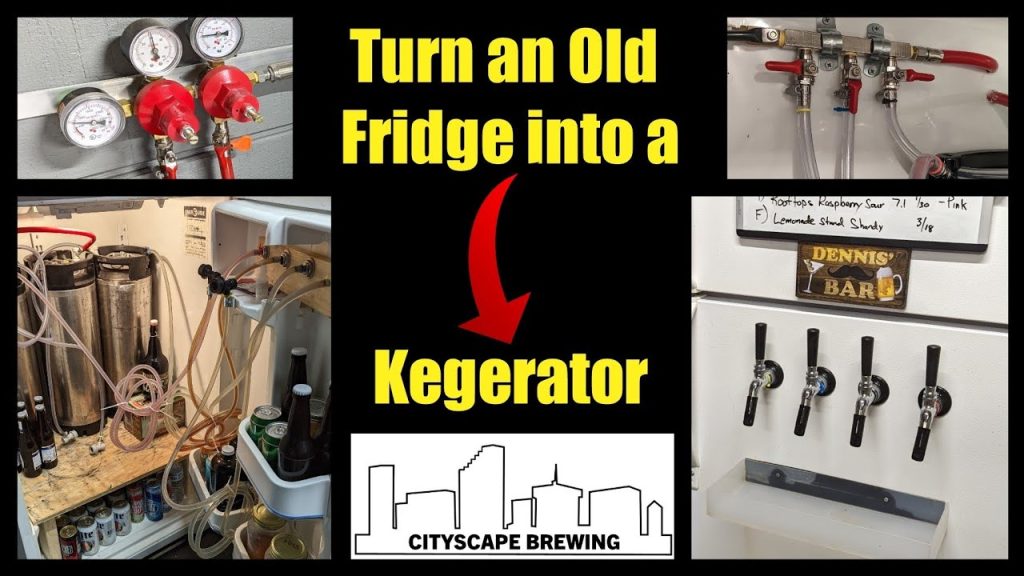
Selecting and Preparing Kegs
Now that your kegerator is all setup and ready to go, it’s time to choose the perfect kegs for your brews. You can either purchase new kegs or repurpose old ones. Just make sure they are in good condition and free of any residual flavors or contaminants. Before using the kegs, you’ll need to clean and sanitize them thoroughly. Use a keg cleaning solution, followed by a sanitizer, to ensure that your beer stays fresh and tasty.
Connecting the Coupler
To tap into the wonderful world of beer, you’ll need to connect the coupler to the keg. Start by lifting the coupler handle and aligning the coupler with the keg’s valve. Gently press down on the coupler, making sure it’s securely in place. Once the coupler is attached, twist it clockwise to lock it into position. This will puncture the keg’s seal and allow the beer to flow. Give it a little tug to make sure it’s properly connected, and you’re ready to start pouring that liquid gold.
Beer Line Balancing
To achieve the perfect pour, you’ll need to balance the length and diameter of your beer line. A balanced beer line ensures that the beer flows smoothly from the keg to your glass, without excessive foam or a slow pour. Factors such as temperature, carbonation level, and line length can affect the balance. If you’re experiencing excessive foam, try increasing the line length or decreasing the pressure. If the pour is too slow, you may need to decrease the line length or increase the pressure. It may take some trial and error to find the right balance, but once you do, you’ll be pouring pints like a pro.
Adding Final Touches
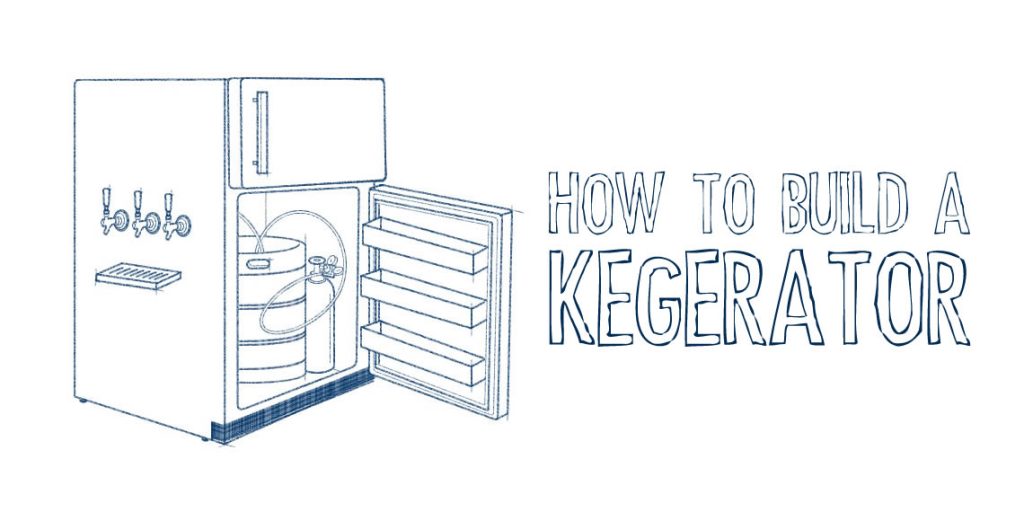
Drip Tray Installation
Nobody likes a soggy bar top, so installing a drip tray is a must. A drip tray catches any excess beer or condensation, preventing messes and keeping your countertop dry and clean. You can choose from a variety of drip trays, ranging from stainless steel to plastic. Simply place the drip tray under the faucet to catch any drips or spills. Make sure to empty and clean the drip tray regularly to avoid any funky smells or buildup.
Temperature Control Enhancement
While most modern fridges have built-in temperature controls, you may want to consider enhancing your kegerator’s temperature control. You can install a digital temperature controller that allows you to set and monitor the temperature with precision. This way, you can ensure that your beer is always stored and served at the optimal temperature for maximum enjoyment. Plus, you’ll have the added benefit of geeking out over the temperature readings like a true beer enthusiast.
Customizing the Exterior
Now that the inside of your kegerator is all setup and functioning perfectly, it’s time to give it a little personality on the outside. Get creative and let your imagination run wild. You can paint the fridge with your favorite brewery’s logo or design your own custom artwork. Or, if you’re feeling nostalgic, how about slapping on some vintage beer labels for a retro look? The options are endless, so grab your paintbrush or stickers and let your kegerator shine.
Troubleshooting and Maintenance
Maintaining Temperature
Keeping your kegerator at the right temperature can sometimes be a challenge. If you notice that the temperature is fluctuating or not holding steady, there are a few things you can check. Make sure the door seal is tight and free of any debris or damage. Clean the condenser coils regularly to keep them running efficiently. If you’re still having trouble, you may need to adjust the temperature control settings or consider upgrading to a more advanced temperature control system. Remember, a happy kegerator equals happy beer.
Cleaning the Draft System
To keep your beer tasting fresh and prevent any off-flavors, regular cleaning of the draft system is essential. Start by taking apart the faucet and soaking it in a cleaning solution. Use a cleaning brush and sanitizing solution to clean the beer lines, couplers, and keg connectors. Rinse everything thoroughly to remove any residual cleaning solution. It’s also a good idea to replace the beer lines and O-rings periodically to ensure a clean and sanitary system. A little bit of cleaning goes a long way in maintaining the quality and taste of your beer.
Replacing Parts
Over time, some parts of your kegerator may start to show signs of wear and tear. If you notice any leaks, funky tastes, or other issues, it may be time to replace certain components. From faucets and shanks to couplers and regulators, there’s a wide range of replacement parts available. Make sure to choose high-quality parts that are compatible with your specific kegerator setup. With a little bit of DIY know-how, you’ll be able to replace parts and get your kegerator back up and running in no time.
Tips and Tricks
DIY Tap Handles
Why settle for boring tap handles when you can design your own DIY masterpieces? Get crafty and make custom tap handles that reflect your personality or showcase your favorite beer styles. You can use wood, epoxy resin, or even repurpose old beer bottles. Look for tap handle kits or get creative with materials you have on hand. Your homemade tap handles will not only add a personal touch to your kegerator but also spark conversations and impress your fellow beer enthusiasts.
Kegerator Maintenance Schedule
To keep your kegerator in top shape, it’s a good idea to establish a regular maintenance schedule. This will help you stay on top of cleaning, sanitizing, and replacing parts before any issues arise. Create a checklist that includes tasks such as cleaning the beer lines, checking CO2 levels, and inspecting seals and fittings. Aim for a monthly or quarterly maintenance routine, depending on how frequently you use your kegerator. A little bit of proactive maintenance will go a long way in preserving the quality and longevity of your beloved beer dispenser.
Efficient Use of CO2
CO2 can be a precious resource when it comes to dispensing beer from your kegerator. To maximize the use of your CO2 tank, consider implementing a few efficiency tips and tricks. First, make sure all your connections are tight and leak-free. Any leaks can result in wasted CO2 and skyrocketing operating costs. Second, store your CO2 tank in a cool place to minimize pressure fluctuations caused by temperature changes. Finally, avoid excessive foam by balancing your beer lines and adjusting the pressure accordingly. By optimizing your CO2 usage, you’ll pour more pints and save some pennies along the way.
Cost Considerations
Budget-Friendly Alternatives
Turning your grandma’s fridge into a kegerator doesn’t have to break the bank. If you’re on a tight budget, there are a few cost-saving alternatives you can consider. Instead of buying a brand new fridge, look for used fridges or keep an eye out for great deals at appliance stores or online marketplaces. You can also repurpose old parts or find budget-friendly alternatives for components like tap towers and regulators. With a little bit of creativity and resourcefulness, you can build a kegerator that fits your budget without compromising on the quality of your beer.
Calculating Operating Costs
While building your DIY kegerator may save you money in the long run compared to buying individual bottles or cans, it’s essential to consider the operating costs. Take into account the price of the kegs, CO2 refills, cleaning and maintenance supplies, and electricity. Remember, your kegerator will be running continuously to maintain the desired temperature and keep your beer flowing smoothly. By calculating the operating costs, you’ll have a clearer picture of how much each pour is really costing you. It may not deter you from enjoying your frosty brews, but it’s always good to have the numbers in mind.
Return on Investment
Building your own kegerator is not just a fun DIY project; it can also be a smart investment. Calculate your return on investment by comparing the cost of building the kegerator to the money you’ll save in the long run. Factor in the price difference between kegs and individual bottles or cans, as well as any potential savings on packaging materials or recycling fees. Consider the convenience and enjoyment you’ll get from having a constant supply of fresh beer on tap. While the return on investment may not be immediate, over time, you may find that your homemade kegerator pays for itself and then some.
Safety Precautions
Handling CO2 Safely
While CO2 is necessary for your kegerator to function, it’s important to handle it safely. Make sure to store your CO2 tank in an upright position, secured to prevent tipping. When connecting or disconnecting the CO2 tank, always release the pressure before making any adjustments. This can be done by slowly turning the pressure adjustment knob counterclockwise until you no longer hear the sound of gas escaping. Remember to wear protective gloves and eyewear when working with CO2 and avoid exposing it to open flames or extreme heat.
Electrical Safety Measures
When working with electrical components, it’s crucial to prioritize safety. Make sure the kegerator is unplugged before making any modifications or adjustments. If you’re not comfortable working with electrical wiring, it’s best to consult a professional to ensure that all connections are properly grounded and safely installed. Also, be mindful of any potential water leaks or spills near electrical outlets or components. Safety should always be the number one priority to prevent any accidents or damage to yourself or your kegerator.
Avoiding Contamination
To keep your beer tasting fresh and free of any off-flavors, it’s important to take precautions to avoid contamination. Always clean and sanitize your kegs, beer lines, and any other components that come into contact with the beer. Use food-grade cleaning and sanitizing solutions and follow the instructions carefully. Regularly inspect and replace O-rings to prevent any leaks or bacterial buildup. Keep your kegerator clean and dry, and handle your beer with care to ensure a safe and enjoyable drinking experience.
In conclusion, turning your grandma’s old fridge into a DIY kegerator can be a rewarding and enjoyable project for beer enthusiasts and homebrewers. From choosing the right fridge to installing the draft system and maintaining your kegerator, each step requires attention to detail and a bit of humor. By following this comprehensive guide, you’ll be pouring refreshing pints of your own homebrew in no time. So, grab your toolbox, put on your DIY hat, and let the beer flow! Cheers!
youhadmeatbeer.com, 2023 (c) All rights reserved. Without previous written consent from youhadmeatbeer.com, no part of this publication may be duplicated or communicated in any way, whether it be electronically, mechanically, photocopying, recording, or otherwise.

